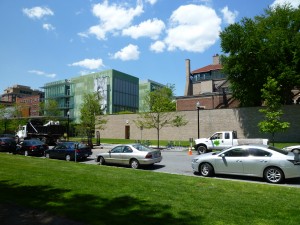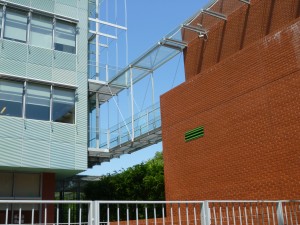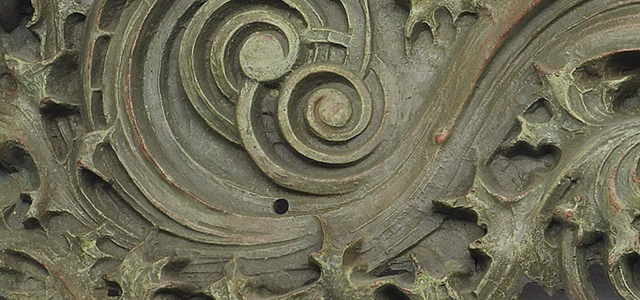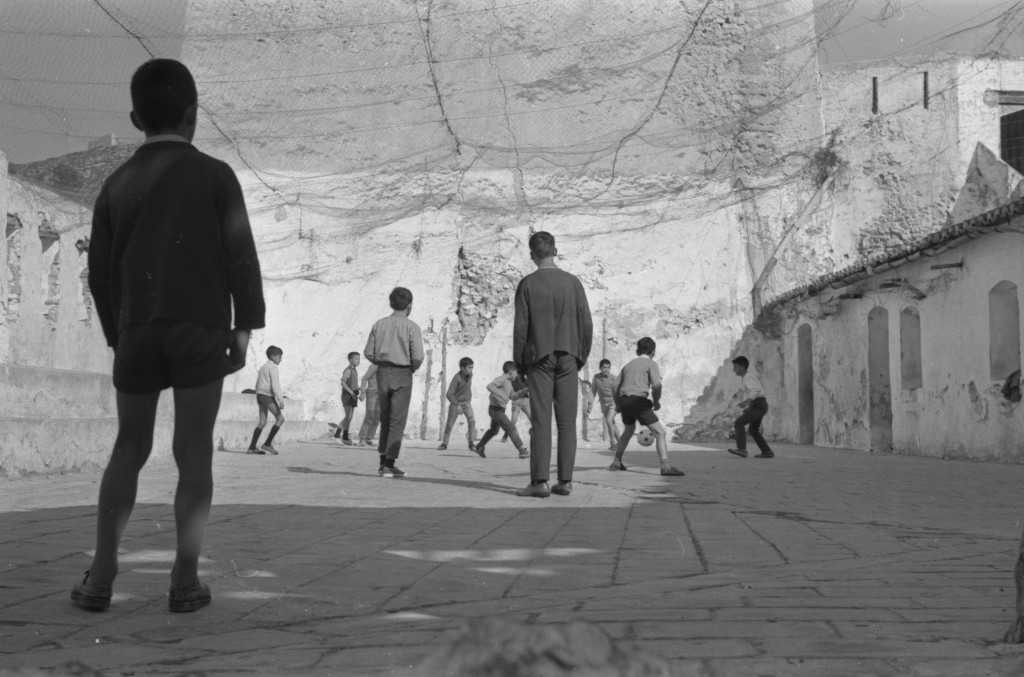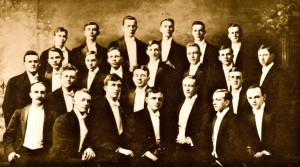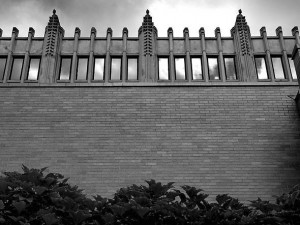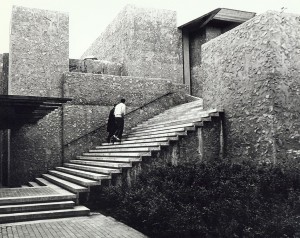CREAM RISES
by Witold | Jul 10, 2013 | Architecture
 A friend who is a composer and musician, wrote to me recently after reading my essay on parametric design in Architect. “What I found surprising is that in the Sixties music was going through much the same thing,” he wrote. “Composers dealt only in parameters, and arranged them according to Set Theory. Milton Babbitt, who had a degree in math before concentrating on music, held forth at Princeton about the use of the Set, as derived from Schoenberg’s twelve-tone theory. Alan Forte at Yale wrote a book called Set Theory, in which you could look up all possible sets, 2 through 12 notes, all categorized and logically laid out. So you didn’t need a computer. Of course Set Theory could be applied to the other parameters, not just pitch.”
A friend who is a composer and musician, wrote to me recently after reading my essay on parametric design in Architect. “What I found surprising is that in the Sixties music was going through much the same thing,” he wrote. “Composers dealt only in parameters, and arranged them according to Set Theory. Milton Babbitt, who had a degree in math before concentrating on music, held forth at Princeton about the use of the Set, as derived from Schoenberg’s twelve-tone theory. Alan Forte at Yale wrote a book called Set Theory, in which you could look up all possible sets, 2 through 12 notes, all categorized and logically laid out. So you didn’t need a computer. Of course Set Theory could be applied to the other parameters, not just pitch.”
Unlike music, architecture is not a theoretical subject, that is, it’s an applied art–an old but still useful term. As such, architecture is based on practice; what succeeds, becomes the canon. That’s why architects have always traveled to look at the great works, since whatever we know about how to build great buildings expands the recognized achievements of the past. As James Stirling wisely observed, “Architects have always looked back in order to move forward.” Nevertheless, from time to time, academically-inclined architects–or architects who simply have time on their hands, that is, architects who are not building–become fascinated by theory. Despite surviving Renaissance treatises, architecture lacks a theoretical foundation, so they look for inspiration in other fields: philosophy, linguistics, biology, morphology, geometry, fine art, perhaps even music.
THE EMPEROR’S CLOTHES
by Witold | Jul 1, 2013 | Architects
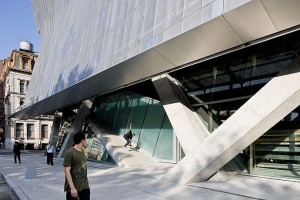 Nicolai Ouroussoff called the Cooper Union Building “a bold architectural statement of genuine civic value.” Paul Goldberger described it as “the most exciting, energetic, and well-composed academic building to go up in the city in at least a decade.” James Russell was only slightly more circumspect: “Mayne’s high-wire act may offer an important lesson in creativity for Cooper’s students.” How could so many New Yorkers be taken in? I thought to myself as I looked across Cooper Square at the building. The photographs I had seen did make the building appear bold and exciting. The impression in real life was very different. The design struck me as a willful exercise in architectural nihilism. Everything you thought you knew about architecture is wrong. Columns should be vertical–wrong. Walls should be straight–wrong. God is in the details–wrong. The context is important–wrong. Buildings should represent some sort of order–wrong. Writing in Slate about the U.S. Federal Building in San Francisco, I once described Mayne as a Mannerist, as much so as Venturi, although Mayne’s vocabulary was industrial rather than historicist. But Cooper Union ventures into darker, dystopic territory. I found this shabby, crabbed design intensely upsetting–and not in a good way. “Thank goodness for the trees,” my wife said.
Nicolai Ouroussoff called the Cooper Union Building “a bold architectural statement of genuine civic value.” Paul Goldberger described it as “the most exciting, energetic, and well-composed academic building to go up in the city in at least a decade.” James Russell was only slightly more circumspect: “Mayne’s high-wire act may offer an important lesson in creativity for Cooper’s students.” How could so many New Yorkers be taken in? I thought to myself as I looked across Cooper Square at the building. The photographs I had seen did make the building appear bold and exciting. The impression in real life was very different. The design struck me as a willful exercise in architectural nihilism. Everything you thought you knew about architecture is wrong. Columns should be vertical–wrong. Walls should be straight–wrong. God is in the details–wrong. The context is important–wrong. Buildings should represent some sort of order–wrong. Writing in Slate about the U.S. Federal Building in San Francisco, I once described Mayne as a Mannerist, as much so as Venturi, although Mayne’s vocabulary was industrial rather than historicist. But Cooper Union ventures into darker, dystopic territory. I found this shabby, crabbed design intensely upsetting–and not in a good way. “Thank goodness for the trees,” my wife said.
TOO MANY WORDS
by Witold | Jun 29, 2013 | Architects, Architecture
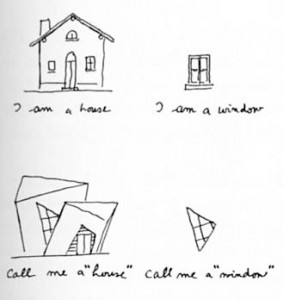 I was listening to a lecture on YouTube by Léon Krier. He was in full apocalyptic mode, his rousing talk illustrated by his charming but barbed drawings. At one point he recounted a quotation: “I wish I could speak a language where no word is repeated.” Krier couldn’t remember the source–it sounds like Marcel Duchamp or Max Ernst to me. In any case, Krier’s point was that this could serve as a maxim for today’s modernist architects, who judge themselves–and are judged–almost solely on their originality. What makes the metaphor so cutting is that a language of unrepeated words would be simply meaningless gobbledygook, which encapsulates Krier’s opinion of the architectural avant-garde. He maintains that meaning in buildings emerges not from the maker’s imagination but from a shared tradition. He characterizes this tradition as a blend (in the proportion of about 20:1) of vernacular and classical. (This formula is an implicit criticism of modern classicists, who drape the orders on everything–big and small, important and humble–with sometimes reckless abandon.) While I was fruitlessly trying to identify the no-repeated-word quotation I came across another. This one from Alexander Pope:
I was listening to a lecture on YouTube by Léon Krier. He was in full apocalyptic mode, his rousing talk illustrated by his charming but barbed drawings. At one point he recounted a quotation: “I wish I could speak a language where no word is repeated.” Krier couldn’t remember the source–it sounds like Marcel Duchamp or Max Ernst to me. In any case, Krier’s point was that this could serve as a maxim for today’s modernist architects, who judge themselves–and are judged–almost solely on their originality. What makes the metaphor so cutting is that a language of unrepeated words would be simply meaningless gobbledygook, which encapsulates Krier’s opinion of the architectural avant-garde. He maintains that meaning in buildings emerges not from the maker’s imagination but from a shared tradition. He characterizes this tradition as a blend (in the proportion of about 20:1) of vernacular and classical. (This formula is an implicit criticism of modern classicists, who drape the orders on everything–big and small, important and humble–with sometimes reckless abandon.) While I was fruitlessly trying to identify the no-repeated-word quotation I came across another. This one from Alexander Pope:
In words, as fashions, the same rule will hold;
Alike fantastic, if too new, or old:
Be not the first by whom the new are tried,
Nor yet the last to lay the old aside.
FANTASY FACTORIES
by Witold | Jun 28, 2013 | Architecture
 Oliver Wainwright writes an excellent article on architectural education in The Guardian. He is particularly good describing the distortions that have accumulated in the so-called academy. Here are some highlights:
Oliver Wainwright writes an excellent article on architectural education in The Guardian. He is particularly good describing the distortions that have accumulated in the so-called academy. Here are some highlights:
Wiry contraptions hang from the ceiling, while globular fungal forms nestle on tables between the spidery legs of 3D-printed creatures. A post-apocalyptic confetti of scalpel blades, empty Pot Noodles and cans of Coke is scattered among this landscape of foreign objects, while a sleeping bag pokes out from under a desk – perhaps with someone still in it.
_____________________________
Attending final presentations as an external critic, it has been striking quite how far students are marshalled under the prescriptive dogma of their tutors in a lot of schools, producing projects with astounding graphic flair, but with a tenuous grip on reality, and often little sign of a critical position. Taught by the same people who mark their work, many students said the safest thing was to keep their heads down and follow the prevailing agenda – or else literally pay for the consequences.
______________________________
With all energies directed towards the climax of the final exhibition – conceived as a salesroom for students and tutors alike – the emphasis is too often weighted on creating a dazzling polished product, rather than the rigour of the process of getting there. Seductive alien imagery trumps the perceived banality of buildings, with the visual cacophony masking the lack of underlying spatial ideas.
_____________________________
The common retreat into introspective dreamworlds can be directly correlated against the dissolution of the architect’s powers, which are increasingly superseded by specialist consultants for every stage of the process.
______________________________
No one has the answer yet, but at least students’ plaintive pleas for relevant teaching are finally being taken seriously – and they may soon have an alternative to costly years trapped in fantasy factories.
SAVE THE STACKS
by Witold | Jun 25, 2013 | Architecture, Modern life
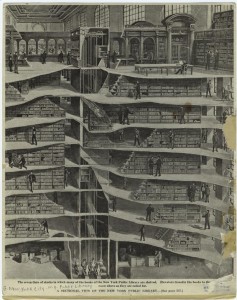 I am lending my voice to those who are calling for a reconsideration of the plan to demolish the stacks beneath the Reading Room of the New York Public Library. While it is true that these stacks are not generally open to the public, they are an integral part of this extraordinary building, a Beaux-Arts design but truly a machine for reading in. As a writer and researcher, libraries–especially public libraries–remain for me special places. Library stacks, even more than reading rooms, are their symbolic heart. I think that one of the things that drew me to writing was the experience of wandering the stacks of McGill’s old Redpath Library, an Erector set of steel shelves, glass-block floors, and low ceilings, clanging steel spiral stairs, murky light, and the smell of old paper. In those days, entering the stacks was a rare privilege reserved for graduate students. I remember the ever-present feeling of surprise whenever I found the book I was looking for, the mysterious LCCN numbers hand-lettered on the spine. And then discovering something even more interesting farther down on the same shelf.
I am lending my voice to those who are calling for a reconsideration of the plan to demolish the stacks beneath the Reading Room of the New York Public Library. While it is true that these stacks are not generally open to the public, they are an integral part of this extraordinary building, a Beaux-Arts design but truly a machine for reading in. As a writer and researcher, libraries–especially public libraries–remain for me special places. Library stacks, even more than reading rooms, are their symbolic heart. I think that one of the things that drew me to writing was the experience of wandering the stacks of McGill’s old Redpath Library, an Erector set of steel shelves, glass-block floors, and low ceilings, clanging steel spiral stairs, murky light, and the smell of old paper. In those days, entering the stacks was a rare privilege reserved for graduate students. I remember the ever-present feeling of surprise whenever I found the book I was looking for, the mysterious LCCN numbers hand-lettered on the spine. And then discovering something even more interesting farther down on the same shelf.
PROBLEM SOLVER
by Witold | Jun 22, 2013 | Architects
I visited the Isabella Stewart Gardner Museum in Boston the other day. I had been there before, but not since the new addition, designed by Renzo Piano. Piano has become a specialist at adding to prominent buildings (Ronchamp, the Morgan Library, the High Museum, and soon the Kimbell Art Museum) and I was curious how he would respond to this rather eccentric museum–a Venetian palazzo in New England. At first glance, the new addition, clad in a green rain-screen, is distinctly odd. It seems to share nothing with its historicist neighbor. But it grew on me. I think that’s because Piano’s architecture has a certain inevitability; when there is a problem, he solves it, when there isn’t, he doesn’t. This needs saying for so many architects today put their energy into dramatically solving aesthetic problems of their own devising, which often results in complicated and eccentric buildings. The Gardner addition is neither. It neatly solves the problem of connecting to the palazzo by a) keeping its distance, and b) aligning the glass link with one of the cloisters, which produces a new entry sequence that actually improves on the original. I particularly liked the back of Piano’s building: ordinary moves but done with a light touch and a razor-sharp intelligence.
THE OTHER STYLE
by Witold | Jun 18, 2013 | Architecture, Design
The first international style in architecture was not the white-box style of Le Corbusier and Walter Gropius but Art Nouveau, modernism’s predecessor and in many ways its aesthetic and philosophical opposite. Art Nouveau flourished from 1890 to 1910, and along the way it produced a surprisingly large number of masters: Gaudí, Hoffmann, Horta, Mackintosh, Plečnik, Sullivan, Van de Velde, and Wagner. And that’s just the leading architects; there were also painters, designers and craftsmen: Beardsley, Klimt, Lalique, Moser, Tiffany. Thirty years is a good long run as architectural fashions go, indeed, the International Style lasted barely that long, nevertheless, modernist apologists have always pooh-poohed Art Nouveau, promulgating the view that “the demise of Art Nouveau was attributable to some fundamental internal flaw,” as Peter Kellow writes in a recent issue of American Arts Quarterly. The modernist apologists were understandably defensive; nobody would ever put a Gropius architectural fragment in a museum, as they would the work of Sullivan and Horta. Moreover, the anti-rationalism of Art Nouveau flew in the face of “scientific” modernism. Yet a quick glance at subsequent history reveals that Art Nouveau was the harbinger of a significant strain of modern architecture, visible in the work of Scharoun, Mendelsohn, Poelzig, the late Wright, and surviving today, though without the exquisite details, in the work of Gehry and Hadid. Though there was a brief revival of Art Nouveau, at least in graphic design, during the psychedelic Sixties, an architectural revival seems unlikely. But you never know. As Kellow writes. “Art Nouveau buildings are surely some of the most beautiful ever designed. Not necessarily the best, but the most beautiful.”
Sant Francesc
by Witold | Jun 13, 2013 | Architecture, Modern life
I took this photo in the spring of 1967, in the village of San Francisco on the Balearic island of Formentera where I was living at the time. The wall in the background is the church of Sant Francesc Xavier, an eighteenth century building, fortified against attacks by the Barbary pirates who periodically descended on the island. The mesh above the court must be there to keep the soccer ball in bounds. I assume that the taller figure is that of the local priest, or brother, acting as a referee, as he is the only one wearing street shoes. I took this with a Leica M3, I think. Like many architecture students (I had just graduated) I was a devotee of sports cars (which I couldn’t afford–my first car was a VW bug, though later I graduated to a Mini Cooper) and cameras (which I could). So what do I like about the photo? Volumes in sun and shade–the Corbusian trilogy–boys at play, the moment frozen forever; it is the world of a 24-year-old architect on the edge of life.
FOLLOW THE MONEY
by Witold | Jun 7, 2013 | Architects
Whenever I hear of complaints about the makeup of the architectural profession, whether it concerns race or gender, I think of a comment by my old teacher, Norbert Schoenauer. He observed that a disproportionate number of the architects working in the housing field in Canada were either Jews or immigrants. He cited Irving Grossman, Jack Diamond, Peter Dickinson, Oscar Newman, Sandy and Blanche van Ginkel, Len Warshaw, Andre and Eva Vescei–and himself. Schoenauer surmised that since housing commissions were less lucrative, they were neglected by established architects, and hence became an opening for “outsiders.” Incidentally, the same was true in the US, think of Emery Roth, Clarence Stein, Bertrand Goldberg, Percival Goodman, and Morris Lapidus. Or Albert Kahn (an immigrant as well as a Jew), who built his practice on designing factories, another neglected field.
Social connections have always been a big part of a successful architectural career. In the early part of the twentieth century, WASP clients tended to hire WASP architects–Burnham, McKim, Hastings, Cram, Platt, Pope, Delano, Atterbury. This started to change when European immigrants (some of whom were also Jews), came to the fore: Schindler, Neutra, Mies, Gropius, Breuer, Belluschi, Sert. When Louis I. Kahn began his career, he joined forces with Oscar Stonorov, likewise an immigrant, and designed mainly housing, but by the 1960s, things had changed and Kahn began to get institutional commissions, and became the leading architect in the US. For the first time, many of the the most prominent names in American architecture were no longer WASPs: not only Kahn, but also Gordon Bunshaft, Max Abramovitz, Minoru Yamasaki, I. M. Pei, Gyo Obata, Frank Gehry, Richard Meier, Robert A. M. Stern, Cesar Pelli. This shift was less due to open-mindedness, although that is a part of the story, as to a change in the nature of the architectural clientele. Yes, talent is important, but you also have to follow the money.
SAD ENDS
by Witold | Jun 2, 2013 | Architects
Ron Thom (1923-1986) is not a name any longer familiar to many, but in the 1960s he was one of Canada’s leading architects, second only to his fellow Vancouverite, Arthur Erickson. Like Erickson, Thom started small, designing prize-winning houses in a woodsy, modernist style that became associated with the West Coast. Like Erickson, he had difficulty translating his exquisite personal designs into the world of large, corporate commissions, and the arc of both architect’s careers contains more tragedy than triumph. Nevertheless, Thom produced at least two masterpieces of collegiate architecture, Massey College (1963) in Toronto and the new campus of Trent University (1963-79) in Peterborough, Ontario. Massey College is unusual in being inspired by Frank Lloyd Wright, at a time when most people consigned the master’s work to the dusty shelf of history. It is doubly unusual in looking back to the young Wright of Midway Gardens and the Imperial Hotel. Perhaps it was Thom’s lack of formal training (he went to art school and studied painting) that enabled him to find something fresh in Wright’s then 50-year-old work. Sadly, Thom’s later buildings did not fulfill the promise of his early masterworks. Like Louis Sullivan, Thom died young (Thom was 63, Sullivan 68) of alcoholism.
Sullivan and Thom’s sad ends are exceptions in the world of architects. According to Vasari, Raphael, who died at only 37, succumbed to excessive love-making, which must be a bitter-sweet end. Usually, when architects die before their time they do so thanks to illness (Richardson, Mendelsohn, Kahn, Saarinen, Stirling). Violent ends are rare: the great Gaudí was killed by a streetcar, Stanford White was murdered by a jealous husband. Most famous architects live long lives, productive until the end (I wrote about this in Slate). I was once told of a Viennese architect who committed suicide when a prominent government building he built was discovered to have no stairs. But surely that is an apocryphal story. Wikipedia lists only nineteen “architects who committed suicide,” although the only widely recognizable name is that of the great Borromini, who suffered from depression.
THE LATEST

Coming October 8

